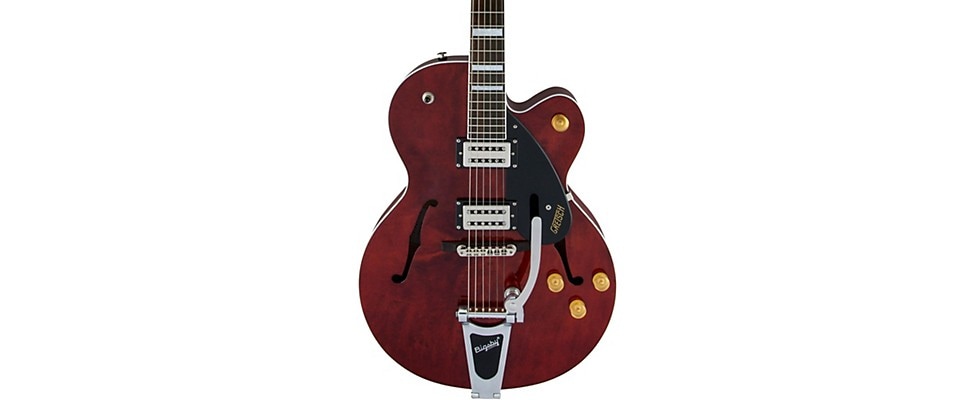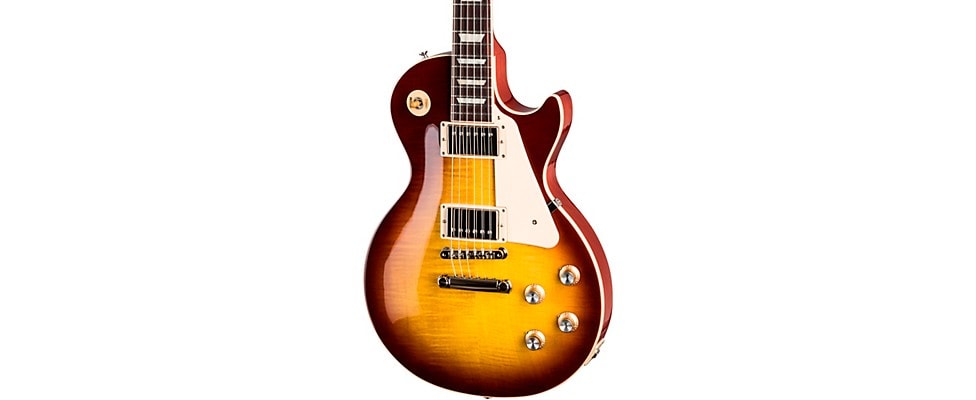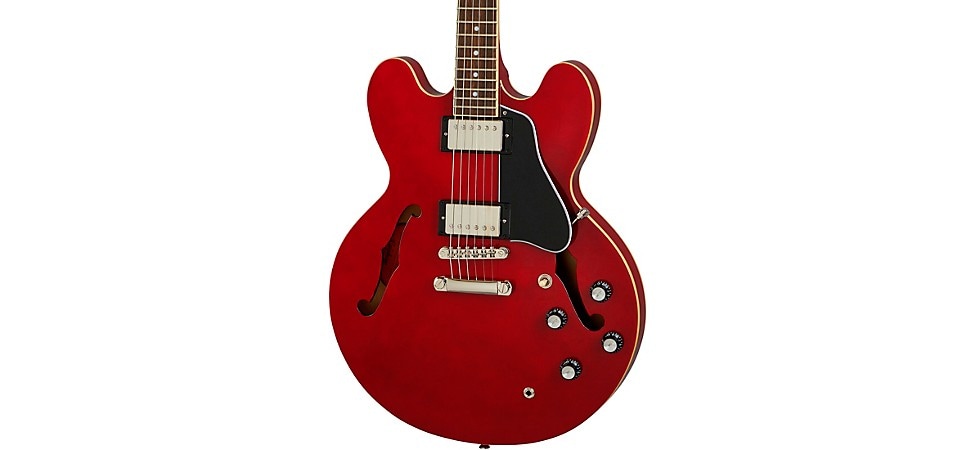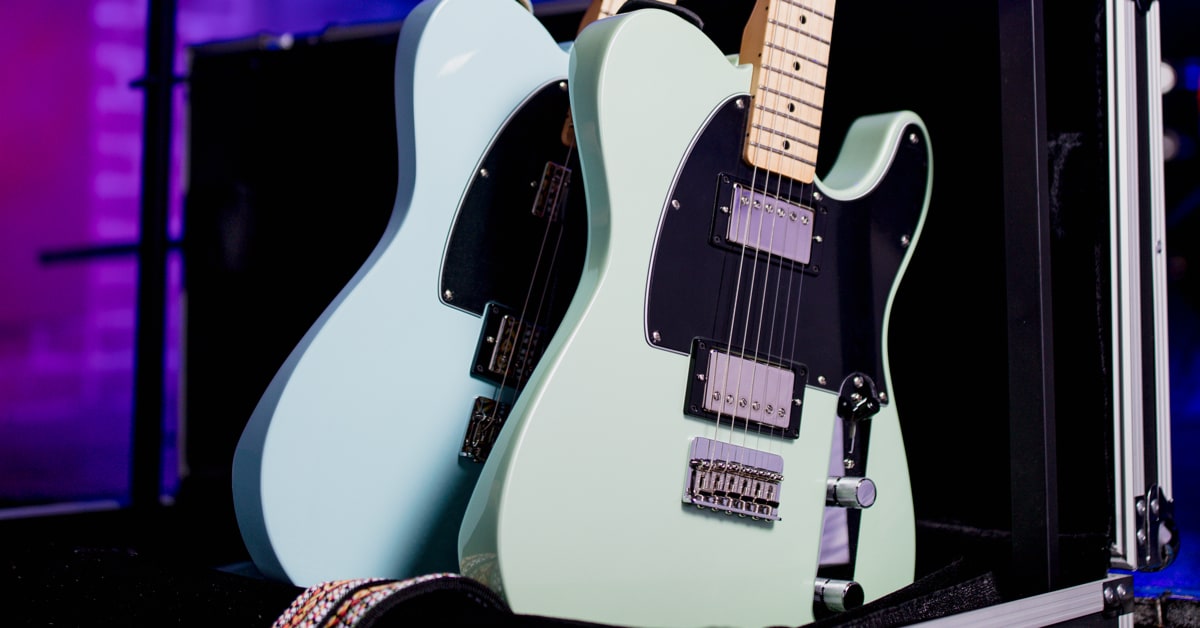To find the electric guitar that’s best for you, you need to know what you’re looking for. The type of music you want to play, the features you want and your budget will help determine the electric guitar you should get. Ultimately, the right guitar for you is the one that feels good in your hands and sounds good to your ears. Even though our online store allows you to conveniently shop the best electric guitar brands from home and have a guitar delivered right to your door, it’s extremely helpful to get hands-on with an electric to get a feel for how it plays and hear how it sounds before buying it. It all comes down to personal preference. Let’s take a look at the characteristics of different types of woods and shapes, as well as the benefits of key features on an electric guitar.
Check out our beginner electric guitar collection to find a perfect entry level electric for yourself or the beginner player in your life.
Table of Contents
Electric Guitar Body Styles
Hollowbody
Solidbody
Semi-Hollowbody
Tonewoods
Popular Body Woods
Popular Neck Woods
Popular Fingerboard Woods
Neck Construction and Neck Shapes
Pickups
Single-Coil Pickups
Humbuckers
Bridges
Trying Out an Electric Guitar In-Store
Questions You May Have When Shopping
Getting the Best Deal on Your Electric Guitar
Become A Better Guitarist With Guitar Lessons
Electric Guitar Body Styles
The three main electric guitar body styles are solidbody, hollowbody and semi-hollow. Electric guitars first appeared in the 1930s, when demand for an amplifiable guitar began to rise from big band players who found themselves unable to compete with the volume of the rest of the band. During the ’30s, brands like Gibson, Rickenbacker and Epiphone began producing archtop hollowbody acoustics with built-in electromagnetic pickups. In 1950, Fender introduced the first commercial solidbody electric guitar with the Esquire (later renamed the Telecaster), which had a “slab” (non-contoured) body. In 1958, Gibson introduced the ES-335, the first semi-hollow electric, which combined a solid block of maple surrounded by the hollow wings of an archtop-body guitar.
Hollowbody
Hollowbody guitars retain the natural, airy and woody sound of an acoustic guitar, but are prone to feedback when amplified at high volume levels. Hollowbody guitars are popular among jazz, country and folk players.
Popular models: Check out our collection of hollowbody electrics from Gretsch, D’Angelico, Ibanez and other top brands.

Pictured: Gretsch G2420T Streamliner Electric Guitar
Solidbody
Solidbody electrics provide more sustain and are less susceptible to feedback. Solidbody electrics are staples in most popular music styles, including rock, country and blues.
Popular models: Check out Fender Telecaster and Stratocaster models or the affordable Squier Tele and Strat alternatives. Plus, explore legendary Gibson Les Paul and SG models and the budget-friendly Epiphone versions of the Les Paul and SG.

Pictured: Gibson Les Paul Standard '60s Electric Guitar
Semi-Hollowbody
Semi-hollowbody electrics combine the style and resonant, warm sound of a hollowbody with the feedback-fighting benefits and longer sustain of a solidbody. Their distinctive tones are popular among rock, blues and rockabilly players.
Popular models: Check out Gibson ES-335 semi-hollow electrics or the more accessible Epiphone semi-hollow models.

Pictured: Epiphone ES-335 Semi-Hollow Electric Guitar
Tonewoods
Tonewoods are varieties of wood with tonal properties—their fundamental sound—that make them good choices for use in instruments. The firmness, weight and density of each species of wood help shape its tone. Every piece of wood within a species will also have unique variations in grain and color, which contribute to the unique look and feel of an electric. Below are some common tonewoods used for the bodies, necks and fingerboards of electric guitars.
Popular Body Woods
Alder
Alder is a medium-weight wood with a strong, clear, full-bodied sound.
Swamp Ash
Swamp ash is light and resonant, offering pleasant highs, firm lows and a slightly scooped midrange.
Northern Ash
Northern ash is slightly denser and heavier with a more cutting sound and is most commonly paired with a carved maple top.
Mahogany
Mahogany is a fairly dense wood that offers natural compression (leveling of dynamics) with strong mids and an overall warmer, more woody tonal range.
Maple
Maple is a dense hardwood generally partnered with a second, lighter wood. An all-maple body produces a bright, focused tone with a fast note decay that cuts through a mix.
Korina
Korina is a fairly light hardwood that yields great clarity, warmth and definition with strong resonance and sustain.
Basswood
Basswood is a very light and fairly soft wood with a well-balanced tonality and a muscular midrange.
Poplar
Poplar is a relatively soft hardwood that is well-balanced sonically, but isn’t particularly resonant or sustaining.
Popular Neck Woods
Maple
Maple necks can impart a lively and bright tone that can help add clarity to the top end of a large-bodied guitar.
Mahogany
Mahogany necks can help add warmth and fatness to the overall tonal range of a guitar.
Carbon Fiber-Reinforced Necks
Carbon fiber rods have little to no effect on tone, but are used to add rigidity and stability to necks, helping protect thinner, faster-playing necks against breakage and excessive bending.
Popular Fingerboard Woods
Ebony
Ebony is a very hard, smooth wood. As a fingerboard, it is fast playing and is very bright sounding with long sustain.
Pau Ferro
Pau ferro is a very hard wood with tighter grain than rosewood, making it smooth and easy to play. Tonally, pau ferro has a slightly snappier tone than rosewood and a warmer tone than ebony.
Maple
Maple fingerboards and one-piece maple necks are fast playing and bright sounding with great sustain.
Rosewood
Historically, rosewood was one of the most commonly used woods for fretboards. However, due to environmental concerns, many manufacturers are transitioning to rosewood alternatives, including ebony and pau ferro.
Neck Construction and Neck Shapes
There are three general types of neck construction. Bolt-on necks are, as the name implies, bolted onto the body of the guitar. This allows for easier repair or replacement, but offers less overall sustain and resonance. Set necks are glued into the body, which creates a more stable neck joint and gives better sustain and resonance to the guitar. The neck of a “neck-through” guitar extends through the entire length of the body, which is even more stable and offers even greater sustain and resonance.
Neck shapes or “profiles” don’t heavily affect the sound of the guitar, but have a great effect on the guitar’s overall feel. C-, U- and V-shaped necks are the three popular neck profiles. The letters refer to the basic shape of the back of the guitar neck. C-shaped necks are the most common, offering a comfortable oval profile that works well for most players. V-shaped necks have a sharper profile preferred by players more comfortable with their thumb hanging over the fretboard. U-shaped or “baseball bat” necks are chunky and rounded, which makes them more comfortable for large-handed players or those who prefer to play with their thumb on the back or side of the neck.
Note: Sometimes, neck profiles are categorized by decade rather than, or in addition to, its shape. The definition of these terms varies slightly by brand but, in general, ’50s necks tend to be rounder and ’60s necks are usually slimmer. “Modern” necks typically have a flatter profile that lend themselves to faster playing.
Pickups
Electric guitars rely on a pickup or multiple pickups mounted on the body to generate a sound that can be amplified by a guitar amp and speakers. Pickups function as a magnetic field, and the vibration created from strumming or plucking the metal strings generates a current. This current is transmitted through the guitar’s preamp circuit, and by using a guitar cable to connect the guitar to an amp, creates an amplifiable signal.
Most electric guitars have a pickup close to the neck and one close to the bridge. The neck pickup produces a thicker, more rounded sound, while the bridge pickup has a clearer, more cutting sound. A three-way pickup switch allows you to choose between these pickups or blend them. If a guitar has a third or middle pickup—most often used blended with either the bridge or neck pickup—it will likely have a five-way pickup selector, which blends the pickups and changes their phase relationship. How you blend these pickups, the circuitry of the guitar’s tone controls, the type of strings you use and your playing techniques will all influence the sound that is sent to the amplifier. Let’s take a look at the two most common pickup types.
Single-Coil Pickups
Single-coil pickups are composed of a magnet, or magnets, with one coil of fine wire wrapped around the pickup to create a magnetic field that captures the strings’ vibrations and converts them into an electronic signal. Single-coil pickups typically have a crisp, cutting sound. This bright tone cuts well through dense bands, but single-coils are also susceptible to hum generated by noise radiation from fluorescent lighting, computer monitors and building wiring.
Humbuckers
Humbucking pickups consist of two out-of-phase coils wired together in series, with the polarity of the magnets arranged opposite each other, which cancels or “bucks” the hum produced by single-coils. Humbuckers tend to have a warmer, smoother tone than single-coil pickups, and lend themselves to thicker rock sounds. Many guitars feature both single-coils and humbuckers, and some guitars feature a “coil tap” switch that turns off one of the coils in the humbucker to offer the player a choice between single-coil and humbucker sounds.
Bridges
The bridge of an electric guitar anchors the ball ends of the guitar strings. The bridge is also where adjustments to the action (the distance between the strings and the frets) and intonation (the accuracy of pitch along the fretboard) can be made. The two main types of electric guitar bridges are fixed (or stoptail) bridges and tremolo (or vibrato) bridges. Tremolo bridges feature a vibrato arm (or whammy bar) that allows players to create vibrato effects by rocking the bridge back and forth to bend the pitch of the strings. Fixed bridges offer more stable tuning and tend to provide more sustain. Locking tremolo systems, like a Floyd Rose bridge, lock the strings in place at the nut and bridge of the guitar, which allows players to heavily use the vibrato arm.
Trying Out an Electric Guitar In-Store
If you need a pick, strap, tuner, slide, capo or a guitar amp to properly compare electric guitar models, ask one of our helpful store staff and they’ll be happy to provide those for you to demo. Don’t feel like you have to put on a demonstration of your talents to get a feel for the guitar. If all you know is a few chords, strum those chords. Hear how those chords sound and how it feels to change between chords up and down the neck. If you haven’t learned to play anything yet, you can pay more attention to the ergonomics of the instrument. See if the body is comfortable to hold, and see if the width of the neck is comfy when gripping it.
Questions You May Have When Shopping
Don’t be afraid to ask questions. Even if you’ve done hours of research on electric guitar forums, you’re not going to become an electric guitar expert overnight. If a guitar you’re looking at has a material or special feature that you’re unfamiliar with, our helpful store staff can explain or quickly find you information on the benefit of that feature. The price tags on each guitar in the store also have bullets, which call out key features. These can include the different tonewoods on the body, neck shapes, pickups and switching.
If you’re unfamiliar with what’s in the store or just need help to find electrics in your price range, you can also ask the sales associate to show you options for the best electric guitar under $500, the best electric guitar under $200 or whatever your budget may be.
Getting the Best Deal on Your Electric Guitar
It never hurts to ask if there are any promotions or sales currently running, but our 45-day price-match guarantee takes the guesswork and haggling out of getting the best deal on electric guitars. At the time of purchase or any time within 45 days of your purchase, if you find the identical guitar advertised by any authorized dealer—including Guitar Center—at a lower price than what you paid, just show us the ad and your original receipt, and we’ll refund you 100% of the difference. Another way to save money on your new electric is by selling us old musical gear you have to trade up to a new electric. So, if you have a qualifying item you’d like to trade in, you can get 10% off your new electric, in addition to your trade credit.
Become A Better Guitarist With Guitar Lessons
Did you know that Guitar Center offers one-on-one guitar lessons for all skill levels? Our expert guitar instructors will work closely with you to tailor your lessons to your musical tastes and goals. Whether you're a beginner using tablature to learn your first riffs, or a more experienced player looking to grow, we're here to help.




